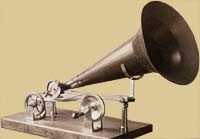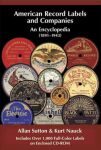RD Gramophone
/ Phonograph Page
____________________
Emile
Berliner & the Gramophone
 Emile
Berliner was born in Hannover, Germany in 1851 and emigrated
to the U.S. in 1870. He sold his improvements to the microphone
in 1878. From the proceeds this generated, he set up a laboratory
in Washington, D.C. and developed the disc phonograph, which he
call the gramophone. Berliner introduced the gramophone in 1888,
but it wasn't until 1894-1895 that he was able to develop this
into a commercial enterprise and begin selling machines and recordings.
The earliest known list of Berliner gramophone "plates"
dates from January 1895 (see LOC link).
Emile
Berliner was born in Hannover, Germany in 1851 and emigrated
to the U.S. in 1870. He sold his improvements to the microphone
in 1878. From the proceeds this generated, he set up a laboratory
in Washington, D.C. and developed the disc phonograph, which he
call the gramophone. Berliner introduced the gramophone in 1888,
but it wasn't until 1894-1895 that he was able to develop this
into a commercial enterprise and begin selling machines and recordings.
The earliest known list of Berliner gramophone "plates"
dates from January 1895 (see LOC link).
 Berliner's
gramophone story is well documented in a terrific Berliner
website hosted by the U.S. Library of Congress. His Canadian
adventures are also well documented (see Canadian
Historical Sound Recordings website), and should be referenced
along with several of the books listed below.
Berliner's
gramophone story is well documented in a terrific Berliner
website hosted by the U.S. Library of Congress. His Canadian
adventures are also well documented (see Canadian
Historical Sound Recordings website), and should be referenced
along with several of the books listed below.
____________________
Fred Gaisberg
Frederick William Gaisberg was born January 1, 1873 and died September 2, 1951.
Fred's earliest association with the phonograph was as piano accompanist
to Columbia Phonograph Company cylinder record artists such as
John York Atlee in 1889 ("The Mocking Bird, by John York
Atlee, artistic whistler, accompanied by Professor Gaisberg"
goes the introduction - Jerrold Moore, pg. 5).
Gaisberg was hired by Emile Berliner to arrange
for recording sessions, and he went on to spent his entire career
in this roll, based out of London. Fred's fascinating story is
best told by Jerrold Moore in "Sound Revolutions" (see
details below) and Fred's autobiography was published in 1942.
Fred is also featured extensively in the EMI Records history (also
below).
____________________
Deutsche
Grammophone
Deutsche Grammophone was
founded in 1898 when Emile Berliner sent his nephew Joseph Sanders
to Hannover to assist Emile's brother Joseph Berliner in establishing
the first disc pressing plant in Europe. Jerrold Moore ("Sound
Revolutions" - see below) tells the story best: "[Sanders]
was to have the task of setting up a factory to press all the
discs taht were to be recorded in Euope, as supply lines from
America would have been impossibly long. The Berliners' fear of
British trade unionism had discouraged the idea of building the
facoty in England. Then Emile Berliner's brother Joseph, in Hannover,
offered to finance the pressing plant if it could be situated
there." (Moore, Sound Revolutions, pg. 37). The reader is
strongly encouraged to read all of Moore's fine book for the complete
story.
In the U.S., the earliest Deutsche Grammophone
pressings were on the Opera Disc label. American Record Labels
and Companies (Sutton & Nauck; see below) describes the
situation thusly: "[Opera Disc Company records were] manufactured
in Germany by Polyphonwerke Aktiengesellschaft, a division of
Deutsche Grammophone Gesellschaft, for sale in the U.S. ... Before
the outbreak of World War I, Victor Talking Machine Co. and Gramophone
Co. (HMV) masters were pressed and distributed in Germany by the
Gramophone Co.'s affiliate, Deutschen Grammophon Aktiengesellschaft
(DGA). DGA maintained studios in Berlin and a large pressing plant
in Hannover. However, with the outbreak of European hostilities
in 1914, Alexander Lucas seized the Victor and HMV masters in
DGA's possession as spoils of war. Having severed relations with
Victor and the Gramophone Co., DGA was reorganized as Deutsche
Grammophon Gesellschaft (DGG), an independent corporation. In
March 1917, Lucas transferred ownership of the Victor and Gramophone
Co. masters to Polyphonweke, a DGG subsidiary that produced records
for export." Please refer to American Record Labels and
Companies for more of this and many other fascinating stories.
Deutsche Grammophon:
http://www.deutschegrammophon.com/home.htms
(more to come!)
____________________
top of page
Recommended
Reading
 |
Since Records Began - EMI, The First 100 Years
(1997 - Peter Martland)
This is the book that got me started! Profusely
illustrated, it traces the phonograph industry from its very
beginnings with Edison and Berliner, through the CD era. The
first 3 chapters are especially helpful for the detailed histories
of Columbia, Berliner, Victor, and of course EMI (a British marriage
of Columbia and Victor affiliates brought about in 1931 by the
depression). Lots of references to Fred Gaisberg, my hero! |
|
The Fabulous Phonograph 1877-1977
(1954, revised 1977 - Roland Gelatt)
A fun read, taking us through the phonograph
era in terms of the music which was recorded at various stages.
Helps to recreate the excitement as each greater recording achievement
was accomplished, from the earliest 7" disc recording days
to the introduction of electrical recording ca. 1925, the LP
ca. 1948, and stereo ca. 1956. |
 |
Sound Revolutions - a Biography of Fred
Gaisberg, Founding Father of Commercial Sound Recording
(1999 - Jerrold Northrop Moore)
Moore does a fantastic job of covering Fred
Gaisberg's life and career with the gramophone and EMI. This
is a must-read, and in many ways is more informative than Gaisberg's
autobiography itself (see below). |
|
The Music Goes Round
(1942 - Fred Gaisberg)
Gaisberg played piano accompaniment on cylinder
records, and turned pages for John Phillip Sousa as a child!
Emile Berliner hired Gaisberg to arrange for recording sessions
as Berliner's gramophone began to gain momentum. Gaisberg was
later hired to move to London, creating Berliner's first recording
studio there in 1898. The rest is history, and you will have
the privalege of reading it here first-hand.
NOTE: this book is long out of print, but
I was able to locate a copy for $20 online. Be patient, they're
out there. Gaisberg also published this book in England after
WWII under another title. |
|
The Talking Machine - the advertising history
of the Berliner Gramophone and Victor Talking Machine
(1997 - James N. Weber)
147 pages of vintage ads reproduced, plus
(alas only) 8 pages reproduced in full color. Weber has done
a great job of uncovering a bounty of material here. This is
apparently a private publication, as it is not available on Amazon.com.
However it is readily available on eBay. ISBN: 0968215106 |
 |
American Record Labels and Companies -
an Encyclopedia (1891-1943)
(2000 - Allan Sutton & Kurt Nauck)
Invaluable book with useful histories of many
American companies, this also mentions Deutsche Grammophon, Polyphon
and other related labels. Comes with a CD-ROM with over 1000
full-color reproductions of record labels. This book is available
from the author's website |
____________________
Cylinder
& 78 links
cylinder record links:
http://tinfoil.com Glenn Sage's excellent cylinder record site (includes
archive of cylinder recordings)
http://www.worldofgramophones.com/bettini.html Bettini Reproducers (lots of nice pics)
78rmp record links:
http://78rpm.com
Kurt Nauck's auction site (lots of interesting items & research
info.)
____________________
top of page
Hi-Fi
and LP links
hi-fi links:
http://www.wam.umd.edu/~losinp/audio.html audio & hi fi links
http://hhscott.com/cc/cctop.htm
http://community-1.webtv.net/KerrB/VINTAGETUBEAMPHORN/page6.html vintage speakers & cabinets - a real labor of
love!!
http://www.vacuumtube.com/
vintage audio gear: http://community-2.webtv.net/hornvox/VINTAGEAUDIOTRADERS/index.html
Record label links:
http://www.bsnpubs.com/discog.html LP discography index page (awesome! mostly non-jazz;
nice compliment to...)
http://www.eclipse.net/~fitzgera/ jazz record label discographies (wonderful stuff!)
Atlantic Records:
http://www.history-of-rock.com/atlantic_records.htm an early history of Atlantic Records
(see also Jerry Wexler's autobiography and "Making Tracks
- The History of Atlantic Records" by Charlie Gillett)

Blue Note Labelography:
http://ronpenndorf.com/labelography.html
http://www.allaboutjazz.com/iviews/vangelder.htm Rudy Van Gelder Interview (Blue Note's recording engineer)
Chess records (and
Aristocrat):
http://hubcap.clemson.edu/~campber/aristocrat.html
(Aristocrat!!)
http://hubcap.clemson.edu/~campber/rsrf.html
(beautiful project to document post-war Chicago music!!)
http://www.jazzinstituteofchicago.org/
http://bluestogold.com/index2.html
Columbia Masterworks LP's
http://ronpenndorf.com/labelography2.html
Deutsche Grammophon
insert link here!
Fantasy Records
Homepage: http://www.fantasyjazz.com/
includes Prestige, Riverside, Milestone, Contemporary, and Good
Time Jazz labels (!); plus Stax, Specialty, Takoma, and Kicking
Mule
Impulse! Records Homepage: http://www.impulserecords.com/
London FFRR LPs
http://community-2.webtv.net/londonLP/VINTAGEAUDIOTRADERS/index.html
http://ronpenndorf.com/labelography5.html
Mercury Living Presence LPs
http://www.xs4all.nl/~rabruil/mercury.html
http://community-2.webtv.net/mercuryLP/Vinaudtraders/index.html
http://edessa.topo.auth.gr/pub/mp3/Mercury_Living_Presence/
(MP3's!)
http://ronpenndorf.com/labelography3.html
RCA Living Stereo tapes & LP's:
http://community-2.webtv.net/rcaLP/VINTAGEAUDIOTRADERS/index.html
http://ronpenndorf.com/labelography5.html
Verve Records Homepage: http://www.ververecords.com/
see Verve history page at http://www.vervemusicgroup.com/verve/history.asp?lid=1
Interesting thoughts on audio recording, mono LP's (and
food!):
http://ronpenndorf.com/journalofrecordedmusic.html
____________________
top of page
This page last updated 9-24-2004
Rob DeLand Geocities Home
 Emile
Berliner was born in Hannover, Germany in 1851 and emigrated
to the U.S. in 1870. He sold his improvements to the microphone
in 1878. From the proceeds this generated, he set up a laboratory
in Washington, D.C. and developed the disc phonograph, which he
call the gramophone. Berliner introduced the gramophone in 1888,
but it wasn't until 1894-1895 that he was able to develop this
into a commercial enterprise and begin selling machines and recordings.
The earliest known list of Berliner gramophone "plates"
dates from January 1895 (see LOC link).
Emile
Berliner was born in Hannover, Germany in 1851 and emigrated
to the U.S. in 1870. He sold his improvements to the microphone
in 1878. From the proceeds this generated, he set up a laboratory
in Washington, D.C. and developed the disc phonograph, which he
call the gramophone. Berliner introduced the gramophone in 1888,
but it wasn't until 1894-1895 that he was able to develop this
into a commercial enterprise and begin selling machines and recordings.
The earliest known list of Berliner gramophone "plates"
dates from January 1895 (see LOC link). Berliner's
gramophone story is well documented in a terrific
Berliner's
gramophone story is well documented in a terrific 


